We’re excited to present our new segmentation templates. Templates give you ideas of how to use segmentations, help you adapt segmentations to your site, and make it easy for you to create additional segmentations in just a few clicks.
They’re a great way to get started with segmentations if you’ve never created or modified one before.
They’re also an excellent solution if you’re a segmentation expert but don’t have time to adjust page group values to fit your favorite segmentation to the site you’re currently working on.
What are segmentations?
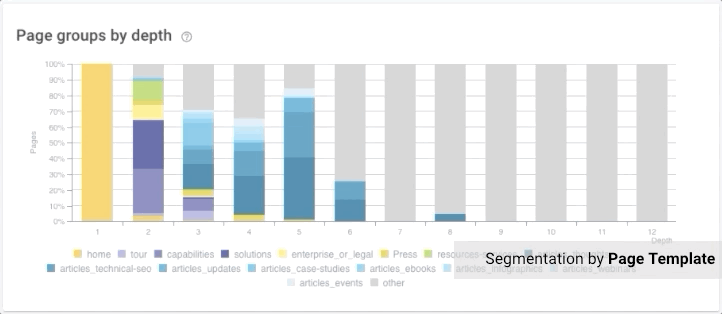
Segmentations are ways to break down the pages of the website you’re analyzing into meaningful groups or sections. This helps you examine types of pages together, rather than attempting to analyze each page individually, or rather than only examining the site as a whole.
Segmentations can reveal trends or problems by making differences between groups of pages much more evident when you’re looking at crawl results.
For example, you might want to group all pages in the /flights/ directory on your site together, all pages in the /cities/ directory together, and all pages in /deals/ together. When looking at content duplication issues, this might help you spot a problem with your “city” template that is producing similar content for most city pages.
Site structure is not the only way to segment a website, however. You might want to focus on your top performing pages, using a segmentation based on the number of organic visits, or on any other metric that you use to evaluate successful SEO.
What’s new for segmentations in Oncrawl?
Oncrawl no longer imposes a default segmentation in new projects, though any existing default segmentations won’t be affected. When you run your first crawl in a new project, you’ll be invited to configure segmentations yourself. Of course, you don’t have to: you can still view all graphics, reports, and data that does not require page groups.
If you want to recreate the default segmentation, you can, using the URL directories template.
When you click the “Configure segmentation” button anywhere in the interface, you’ll notice that the list of segmentations now has a second tab, where the available templates are listed.
And when you click “Create a new segmentation”, you now have a fourth method available:
- Start from scratch: build a segmentation by creating your own page groups based on any metric or combination of metrics in Oncrawl
- Start from JSON: upload a saved segmentation in JSON format
- Start from field: use all values in a field, such as URL first path (the highest-level directory in your URL structure) or hostname, to establish page groups
- Start from a template: use a template from the new template library
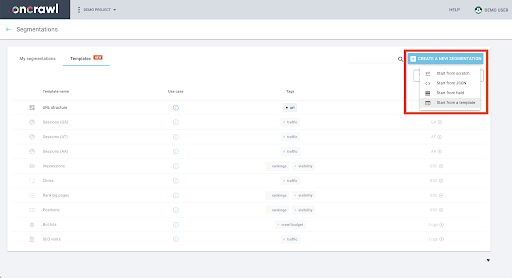
Starting from a template has several advantages, particularly if you’ve never created an Oncrawl segmentation before.
The strengths of Oncrawl’s segmentations
In Oncrawl, segmentations are at the heart of how you understand your analysis results.
It goes without saying, you can have multiple segmentations for the same project, and you can easily switch between different segmentations while viewing a report.
In Oncrawl, segmentations offer a lot of flexibility to provide you with the precise view you need:
- Segmentations can be based on any metric, and you can even combine metrics.
- The creation interface lets you place URLs in multiple groups at once, but also provides the tools to ensure that there is no overlap between groups, if you prefer.
- Segmentations can contain multiple levels. For example, an ecommerce site might differentiate between product and category pages, but then want to break down the product pages between those that are in stock and those that are out of stock.
- Some segmentations can be relative (based on changing data, like the current date) or dynamic (based on metrics that vary over time for a given URL, like the number of organic sessions).
Most importantly, Oncrawl’s segmentations can be created and modified at any time, and even applied retroactively to crawls that have already been completed. This means that you don’t need to launch a new crawl if you need to fix your segmentation.
The advantages of Oncrawl’s segmentation templates
Templates put custom segmentations directly in your hands. With templates, creating segmentations is fast and easy: you choose the template, preview your site structure, and decide whether or not to use the template. You can then adjust or modify the template, its groups, or its name, if you want to customize it further.
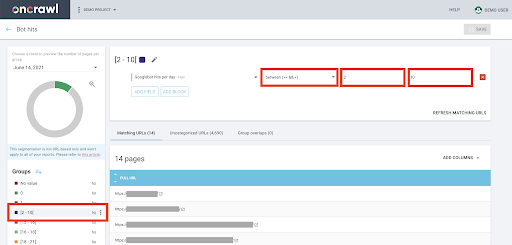
Segmentation templates can help you come up with new ideas for ways to break down and understand your website data. You can use multiple templates, or even use a single template multiple times, modified to capture nuances specific to your particular website. When viewing any dashboard, switch easily between segmentations using the dropdown menu.

Additionally, segmentation templates can be used as demos to understand how to benefit from all of the advantages of Oncrawl’s segmentations. For example, many are dynamic, adjusting to new data with each crawl. A template based on the number of bot hits in the past 45 days won’t necessarily place the same pages in the same groups in a September analysis as it did in an April one. Once you experiment with the template, you’ll be ready to apply what you learn to other metrics in additional segmentations.
Finally, Oncrawl’s segmentation templates adapt to your site, based on an analysis of your site’s data for the metric they are based on. For example, a template based on URL directories will take into account the structure of URLs on your site; a template based on Google Search Console impressions will create groups adapted to your actual volumes of impressions rather than using standardized ranges.
Available segmentation templates
Current available templates include segmentations based on the following metrics:
- URL directory structure
- Analytics sessions
- Google Search Console impressions
- Google Search Console clicks
- Ranking pages
- Average SERP position
- Bot hits in log files
- SEO visits in log files
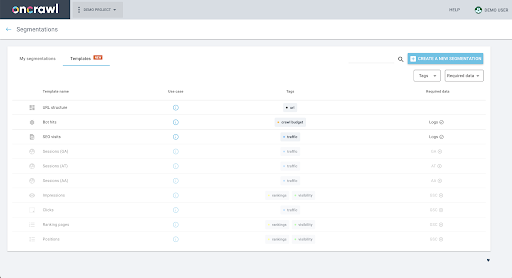
How to access Oncrawl’s segmentation templates
Creating segmentations is free and included for all Oncrawl users.
Likewise, segmentation templates are also available in all plans and for all projects. Click on the “Configure Segmentation” button on your project home page or on any analysis page to access the Segmentation Explorer.
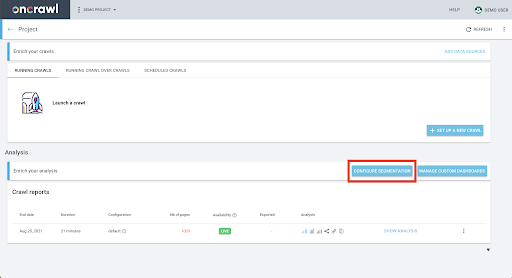
Then, click on the “Templates” tab.

To activate templates that require additional data, that data needs to be present in your project. That means that to unlock the template based on Google Analytics sessions, you must first connect Google Analytics data to your account.
Click on an active template in the list to preview it with your site’s data.
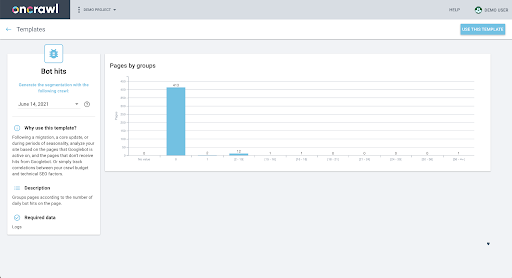
Click “Use this template” and you’re ready to go!
If you’re not an Oncrawl user yet, discover how segmentations work during your free trial:

